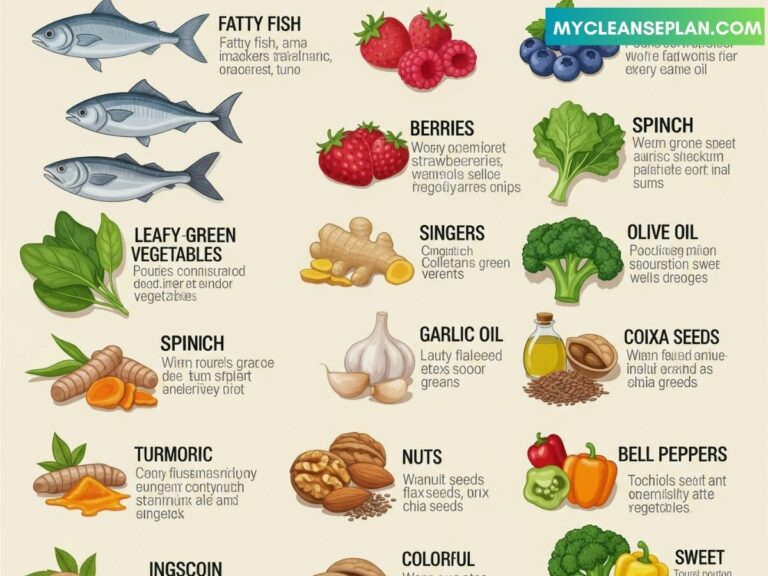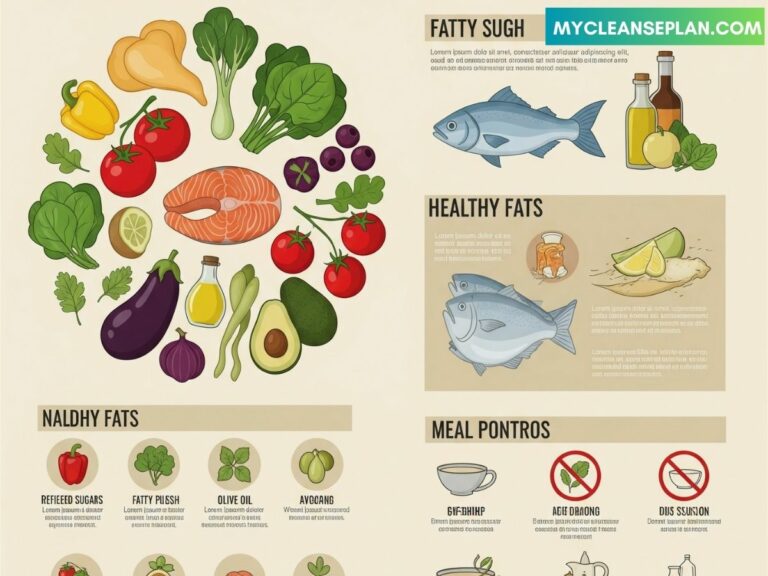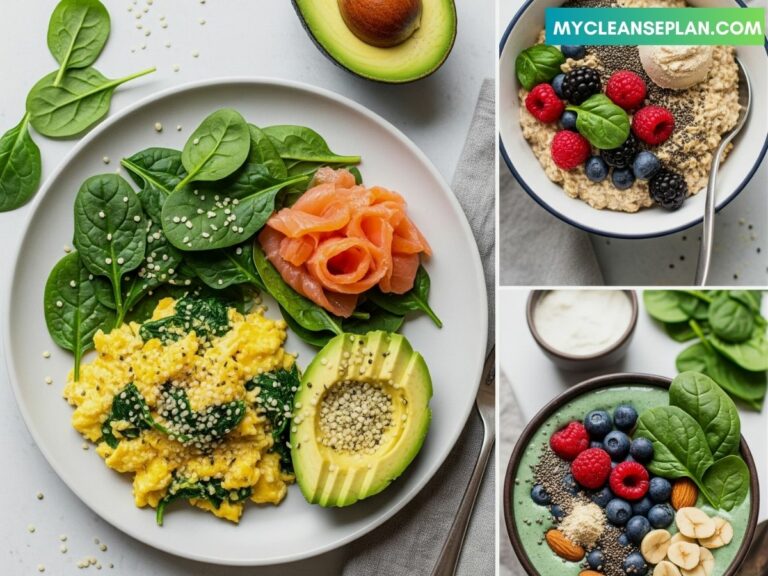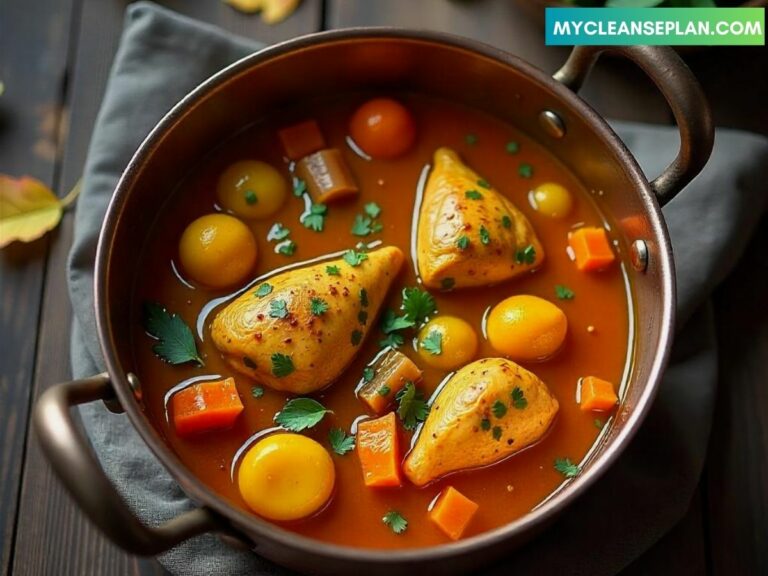Anti-Inflammatory Spices to Add to Your Meals
I still remember my grandmother’s kitchen, filled with the aroma of various inflammation-fighting spices that not only made our meals delicious but also packed with health benefits.
Chronic inflammation is a growing concern in today’s fast-paced world, and incorporating spices with anti-inflammatory properties into our diet can be a simple yet effective way to combat it.
As I delved deeper into understanding the impact of inflammation on our health, I realized that certain spices have been used for centuries to reduce inflammation and promote overall well-being.
By adding these spices to our meals, we can not only enhance the flavor but also boost our health.
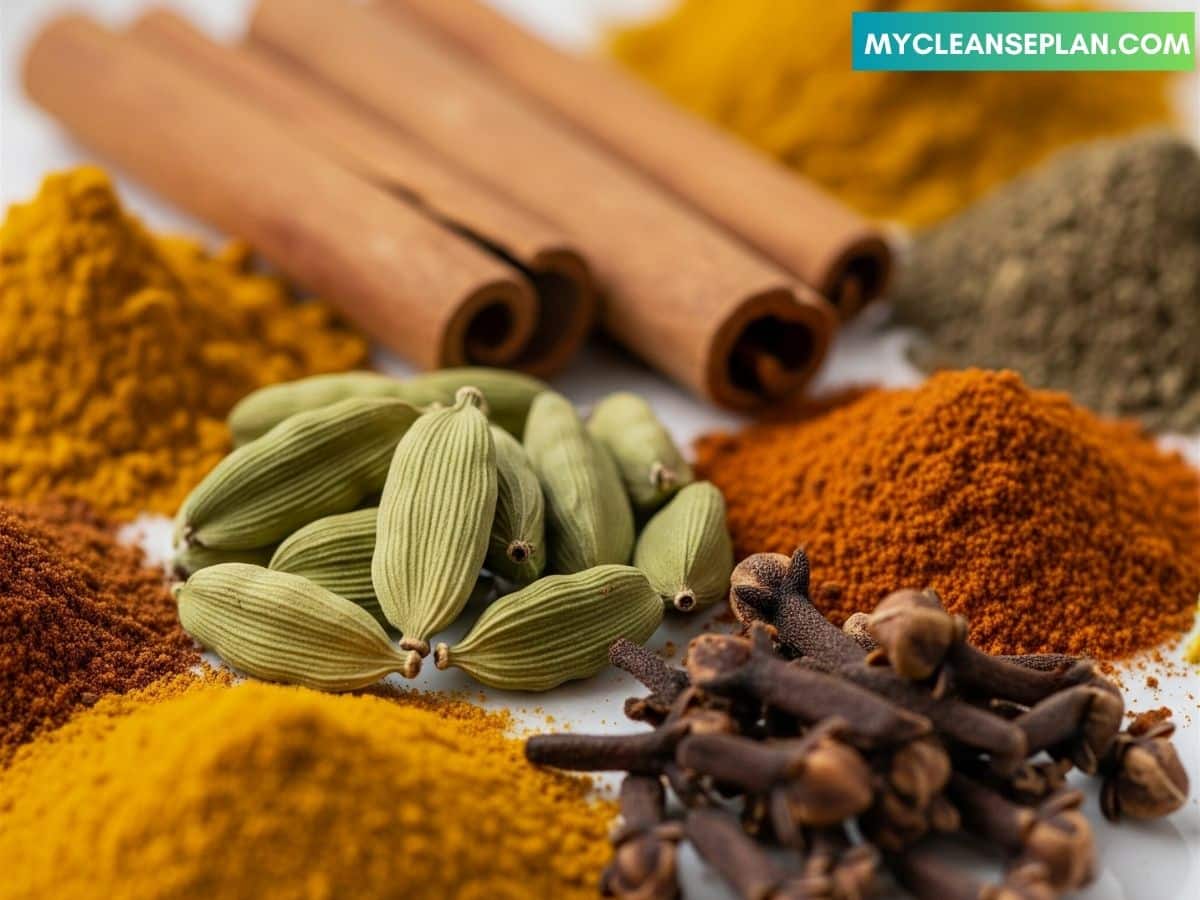
Key Takeaways
Understanding Inflammation and Its Impact on Health
The relationship between inflammation and health is intricate, and grasping this concept is key to making informed dietary choices.
Inflammation is a natural response of the body’s immune system, but when it becomes chronic, it can lead to various health issues.

Acute vs. Chronic Inflammation
Acute inflammation is a short-term response to injury or infection, whereas chronic inflammation persists over time and can lead to conditions like arthritis and heart disease. Understanding the difference is crucial for managing health.
How Diet Influences Inflammation Levels
Diet plays a significant role in inflammation. Consuming foods high in sugar and saturated fats can exacerbate inflammation, while foods rich in antioxidants and omega-3 fatty acids can help reduce it. Incorporating anti-inflammatory spices into your diet is a simple way to start.
Common Inflammatory Conditions
- Arthritis
- Diabetes
- Heart Disease
These conditions can be managed or mitigated through dietary changes, including the use of best spices for reducing inflammation.

Cooking with anti-inflammatory spices not only enhances flavor but also contributes to a healthier lifestyle. By understanding inflammation and its impact, we can make informed choices to improve our health.
The Science Behind Anti-Inflammatory Foods
The role of anti-inflammatory foods in maintaining health is backed by a growing body of research.
As I explore the science behind these foods, it becomes clear that certain compounds within them play a crucial role in reducing inflammation.
How Anti-Inflammatory Compounds Work in the Body
Anti-inflammatory compounds work by interacting with various biological pathways in the body. For instance, some compounds inhibit the production of pro-inflammatory cytokines, which are molecules that promote inflammation.
Others may enhance the production of anti-inflammatory cytokines, thereby reducing inflammation.
One of the key mechanisms through which anti-inflammatory foods exert their effects is by modulating the body’s immune response.
This modulation can lead to a decrease in chronic inflammation, which is associated with various health conditions.
https://gigasecurehome.com/how-many-ring-cameras-can-you-have-on-one-account
Research-Backed Benefits of Reducing Inflammation
Reducing inflammation through dietary approaches has been linked to numerous health benefits. Research has shown that a diet rich in anti-inflammatory foods can help manage conditions such as arthritis, cardiovascular disease, and even certain mental health disorders.
- Reduced risk of chronic diseases
- Improved symptoms in conditions like arthritis
- Enhanced cardiovascular health
Complementing Medications with Dietary Approaches
Incorporating anti-inflammatory spices into your diet can complement medical treatments. While medications are often necessary to manage inflammatory conditions, dietary changes can enhance their effectiveness and potentially reduce the required dosage.
For example, turmeric contains curcumin, a compound with potent anti-inflammatory properties. Consuming turmeric or curcumin supplements alongside conventional treatments can lead to better outcomes in managing inflammation.

In conclusion, understanding the science behind anti-inflammatory foods highlights their potential in improving health outcomes. By incorporating these foods into our diet, we can take a proactive approach to managing inflammation and enhancing our overall well-being.
Why Spices Are Powerful Anti-Inflammatory Agents
Spices are more than just a way to add taste to meals; they contain powerful compounds that can help reduce inflammation.
These natural ingredients have been used for centuries in various cultures for their medicinal properties.
https://gigasecurehome.com/ring-doorbell-flashing-blue-and-not-connecting-causes-and-fix
Concentration of Bioactive Compounds in Spices
Spices are particularly effective due to their high concentration of bioactive compounds. For instance, turmeric contains curcumin, a potent anti-inflammatory agent that has been shown to reduce inflammation in numerous studies.
Historical Use of Spices as Medicine
Historically, spices were used not just for flavor but as medicine. Many cultures relied on spices like ginger and cinnamon for their healing properties, a practice that continues today.
Advantages of Spices Over Supplements
Using spices as anti-inflammatory agents has several advantages over supplements. Spices are generally more accessible and can be easily incorporated into daily meals, making them a sustainable choice for long-term health benefits.

Turmeric: The Golden Anti-Inflammatory Powerhouse
As a frequent user of turmeric in my cooking, I’ve discovered its incredible benefits in reducing inflammation and enhancing overall health.
Turmeric, with its active ingredient curcumin, is a potent anti-inflammatory agent that has been used for centuries in traditional medicine.
Curcumin and Its Proven Benefits
Curcumin is the bioactive compound in turmeric responsible for its anti-inflammatory properties. Studies have shown that curcumin can significantly reduce inflammation by inhibiting various molecules that play a role in the inflammatory process.
The benefits of curcumin are vast, ranging from alleviating symptoms of arthritis to potentially reducing the risk of chronic diseases such as heart disease and diabetes. Its antioxidant properties also help in protecting against cell damage.
Ways to Enhance Turmeric Absorption
To maximize the benefits of turmeric, it’s essential to enhance the absorption of curcumin. Consuming turmeric with a fatty meal or adding a pinch of black pepper can significantly improve its bioavailability.
| Method | Description | Benefit |
|---|---|---|
| Consuming with Fat | Add turmeric to meals with healthy fats like olive oil or coconut milk. | Improves curcumin absorption. |
| Adding Black Pepper | Mix a pinch of black pepper with turmeric. | Piperine in black pepper enhances curcumin bioavailability. |
My Favorite Turmeric Recipes and Applications
I love incorporating turmeric into my daily meals, from golden milk lattes to turmeric-spiced roasted vegetables.
One of my favorite recipes is a simple turmeric and ginger tea that not only warms the soul but also provides a potent anti-inflammatory boost.

By incorporating turmeric into your diet and using the tips provided, you can harness its powerful anti-inflammatory benefits to improve your overall health and well-being.
Ginger: A Warming Anti-Inflammatory Root
I’ve always been fascinated by ginger’s ability to combat inflammation, making it a staple in my kitchen for both culinary and medicinal purposes.
Ginger has been used for centuries in traditional medicine, and its benefits are now being validated by modern research.
Active Compounds in Ginger That Fight Inflammation
Ginger contains several active compounds, including gingerol and shogaol, which have potent anti-inflammatory effects.
These compounds work by inhibiting the production of pro-inflammatory chemicals in the body, thus reducing inflammation.

Fresh vs. Dried Ginger: Which to Choose When
Both fresh and dried ginger have their uses. Fresh ginger is great for adding to teas, stir-fries, and salads, providing a more vibrant flavor.
Dried ginger, on the other hand, is more concentrated and can be used in baking or making spice blends.
Creative Uses for Ginger in Everyday Cooking
There are numerous ways to incorporate ginger into your daily meals. You can add it to your morning smoothie, use it in marinades for meats, or make a soothing ginger tea. Some of my favorite ways include:
- Adding fresh ginger to soups and stews for an extra kick
- Making a ginger and honey paste to spread on toast
- Including dried ginger in homemade curry powders
By incorporating ginger into your diet, you can harness its anti-inflammatory properties to enhance your overall health.
Cinnamon: Not Just for Sweet Treats
Cinnamon, a staple in many kitchens, is not just for baking; it’s a powerful anti-inflammatory spice that can enhance savory dishes.
This versatile spice has been used for centuries, not only for its flavor but also for its medicinal properties.
Ceylon vs. Cassia: Choosing the Right Cinnamon
When it comes to cinnamon, there are two main types: Ceylon and Cassia. Ceylon cinnamon, often referred to as “true cinnamon,” is known for its lighter color and more delicate flavor. It is also considered to have a higher quality and more pronounced health benefits compared to Cassia cinnamon.
Cassia cinnamon, on the other hand, is more commonly found in supermarkets and has a stronger, more bitter taste.
Anti-Inflammatory and Blood Sugar Benefits
Cinnamon is rich in anti-inflammatory compounds that can help reduce inflammation in the body. This makes it a valuable spice for those looking to manage chronic inflammatory conditions. Additionally, cinnamon has been shown to have a positive effect on blood sugar levels, making it a beneficial addition to the diet of individuals with diabetes or prediabetes.
Incorporating Cinnamon in Savory Dishes
While cinnamon is traditionally used in sweet dishes, it can also add depth and warmth to savory recipes.
Try adding a pinch of cinnamon to your stews or chili for an extra layer of flavor. Cinnamon pairs well with lamb, beef, and vegetable dishes, and can be used to add complexity to sauces and marinades.
By incorporating cinnamon into your cooking, you can not only enhance the flavor of your meals but also reap its anti-inflammatory benefits.
Garlic and Onions: Sulfur-Rich Inflammation Fighters
When it comes to natural anti-inflammatory spices, garlic and onions are among the most potent and versatile options available. These ingredients are not only staples in many cuisines but also rich in sulfur compounds that have been shown to possess significant anti-inflammatory properties.

Allicin and Other Beneficial Compounds
Garlic contains allicin, a compound that has been extensively studied for its anti-inflammatory effects. Allicin works by inhibiting certain enzymes that promote inflammation in the body. Onions, on the other hand, are rich in quercetin, a flavonoid with powerful anti-inflammatory properties. Together, garlic and onions form a potent duo that can be easily incorporated into daily meals to enhance their anti-inflammatory benefits.
Key compounds in garlic and onions include:
- Allicin
- Quercetin
- Other sulfur-containing compounds
Preparation Methods That Maximize Health Benefits
The way garlic and onions are prepared can significantly impact their anti-inflammatory benefits. Crushing or chopping garlic releases allicin, making it more bioavailable. Similarly, chopping or slicing onions can enhance the release of quercetin.
Cooking methods, such as sautéing or roasting, can also help retain these beneficial compounds.
“The art of cooking is not just about following recipes, but understanding how to unlock the nutritional potential of ingredients like garlic and onions,” says a renowned chef.
Building Flavorful Bases for Anti-Inflammatory Meals
Garlic and onions are fundamental in creating flavorful bases for a variety of dishes, from soups to stir-fries.
By incorporating these ingredients into your cooking, you not only enhance the taste but also boost the anti-inflammatory profile of your meals.
Experimenting with different preparation methods and combining garlic and onions with other anti-inflammatory spices can lead to delicious and healthful culinary creations.
Anti-Inflammatory Spices to Add to Your Meals: Pepper Varieties
Pepper varieties, including black pepper and cayenne, are not just flavor enhancers but also powerful anti-inflammatory agents.
These spices have been used for centuries not only to add heat and depth to dishes but also for their medicinal properties.
Black Pepper and Piperine: The Bioavailability Enhancer
Black pepper contains a compound called piperine, which has been shown to enhance the bioavailability of other anti-inflammatory compounds, such as curcumin in turmeric. This means that when consumed together, the anti-inflammatory effects are significantly amplified.
Key Benefits of Piperine:
- Enhances bioavailability of other anti-inflammatory compounds
- Has antioxidant properties
- May help in reducing inflammation
Cayenne and Capsaicin: Heat That Heals
Cayenne pepper, known for its spicy heat, contains capsaicin, a compound with potent anti-inflammatory properties.
Capsaicin has been studied for its ability to reduce pain and inflammation, making it a valuable addition to an anti-inflammatory diet.
“Capsaicin has been shown to reduce the production of a chemical that transmits pain signals to the brain, making it a potential natural pain reliever.”
Strategic Combinations with Other Anti-Inflammatory Spices
Combining pepper varieties with other anti-inflammatory spices can create powerful synergies. For example, pairing black pepper with turmeric enhances the absorption of curcumin, while combining cayenne with ginger can amplify their anti-inflammatory effects.
| Spice Combination | Anti-Inflammatory Effect |
|---|---|
| Black Pepper + Turmeric | Enhanced curcumin absorption |
| Cayenne + Ginger | Amplified anti-inflammatory effect |

Aromatic Anti-Inflammatory Spices: Cloves, Cardamom, and Star Anise
In the realm of anti-inflammatory cooking, cloves, cardamom, and star anise stand out for their aromatic and health benefits.
These spices have been integral to various global cuisines, not only for their flavor but also for their medicinal properties.
Unique Compounds and Benefits in Each Spice
Each of these aromatic spices contains unique compounds that contribute to their anti-inflammatory effects.
For instance, cloves are rich in eugenol, a compound known for its analgesic and anti-inflammatory properties.
Cardamom contains cineole, which has been shown to have antioxidant properties. Star anise is a rich source of shikimic acid, used in the production of oseltamivir, an antiviral medication.
- Cloves: Eugenol helps in reducing inflammation and pain.
- Cardamom: Cineole aids in digestion and has antioxidant effects.
- Star Anise: Shikimic acid is crucial for its antiviral properties.

Traditional Uses in Global Cuisines
These spices have been used traditionally in various cuisines around the world. Cloves are commonly used in Indian and Middle Eastern dishes, cardamom is a staple in Scandinavian baking and Indian cuisine, and star anise is frequently used in Chinese cooking.
Creating Custom Anti-Inflammatory Spice Blends
By combining these aromatic spices, you can create custom blends that not only enhance the flavor of your dishes but also provide anti-inflammatory benefits.
A simple blend could include equal parts of ground cloves, cardamom, and star anise, mixed with other anti-inflammatory spices like turmeric and ginger.
Herbs with Anti-Inflammatory Properties: Rosemary, Oregano, and Thyme
My favorite herbs for combating inflammation are rosemary, oregano, and thyme, which can be easily integrated into daily cooking.
These herbs are not only flavorful but also packed with anti-inflammatory compounds that can enhance the health benefits of your meals.
Fresh vs. Dried: Preserving Anti-Inflammatory Properties
When it comes to preserving the anti-inflammatory properties of herbs, the choice between fresh and dried can be crucial.
Drying herbs can concentrate their bioactive compounds, making them potentially more potent than their fresh counterparts.
However, fresh herbs have their own benefits, offering a broader spectrum of volatile compounds that can complement their dried versions.

Mediterranean-Inspired Anti-Inflammatory Cooking
Mediterranean cuisine is renowned for its liberal use of herbs like rosemary, oregano, and thyme, making it a perfect inspiration for anti-inflammatory cooking.
By incorporating these herbs into your dishes, you can not only enhance flavor but also tap into their health benefits. Consider creating herb-infused oils or adding them to soups and stews for an extra boost.
Growing Your Own Anti-Inflammatory Herb Garden
Growing your own herb garden is a simple and rewarding way to ensure a steady supply of fresh rosemary, oregano, and thyme.
This not only allows you to control the cultivation methods but also encourages the use of these herbs in your daily cooking, potentially increasing the anti-inflammatory effects of your diet.
Practical Tips for Incorporating Anti-Inflammatory Spices Daily
Morning Rituals: Anti-Inflammatory Beverages
You can easily incorporate anti-inflammatory spices into your daily life with some simple strategies.
By making a few adjustments to your daily routines and meal preparations, you can harness the benefits of these powerful spices.
Starting your day with anti-inflammatory beverages can set a healthy tone. Consider making a warm drink with turmeric, ginger, or cinnamon. These spices not only add flavor but also provide significant anti-inflammatory benefits.
Spice Blends for Quick Meal Preparation
Preparing spice blends in advance can make incorporating anti-inflammatory spices into your meals effortless.
Create a blend with spices like turmeric, black pepper, and ginger, and use it to season your meals throughout the week.
| Spice Blend | Ingredients | Usage |
|---|---|---|
| Turmeric Blend | Turmeric, Black Pepper, Ginger | Soups, Stews, Vegetables |
| Ginger Zinger | Ginger, Cinnamon, Cloves | Oatmeal, Yogurt, Smoothies |
| Cinnamon Spice | Cinnamon, Nutmeg, Cardamom | Baked Goods, Fruits, Desserts |
Addressing Common Challenges and Taste Preferences
Incorporating anti-inflammatory spices can sometimes be challenging due to personal taste preferences or dealing with picky eaters. Here are some solutions:
Solutions for Picky Eaters
For those who are hesitant to try new flavors, start by incorporating small amounts of anti-inflammatory spices into familiar dishes. For example, add a pinch of cinnamon to your morning oatmeal or sprinkle some turmeric into your favorite soup.
Managing Strong Flavors
Some anti-inflammatory spices, like ginger and garlic, have strong flavors. Balance these by pairing them with complementary spices or ingredients. For instance, pair ginger with honey to balance its heat.
FAQ Of Anti-Inflammatory Spices to Add to Your Meals
What are anti-inflammatory spices, and how do they work?
Anti-inflammatory spices are ingredients that contain compounds that help reduce or manage inflammation in the body. They work by interacting with the body’s biological processes to minimize inflammation, which can help alleviate symptoms of various health conditions.
Can I use anti-inflammatory spices as a replacement for my medication?
While anti-inflammatory spices can be beneficial, they should not be used as a replacement for prescribed medication without consulting a healthcare professional. These spices can complement medical treatments, but they are not a substitute for professional medical advice.
How do I incorporate anti-inflammatory spices into my diet?
You can incorporate anti-inflammatory spices into your diet by adding them to your meals, using them in spice blends, or making teas and beverages. Start with small amounts and adjust to taste, as some spices can be quite potent.
Are there any side effects of consuming anti-inflammatory spices?
Generally, anti-inflammatory spices are safe when consumed in typical culinary amounts. However, excessive consumption can lead to gastrointestinal issues or allergic reactions in some individuals. Always consume spices in moderation.
Can I grow my own anti-inflammatory herbs and spices?
Yes, many anti-inflammatory herbs like rosemary, oregano, and thyme can be grown at home. This not only ensures a fresh supply but also allows you to control how they are cultivated, potentially maximizing their health benefits.
How do I choose the best anti-inflammatory spices for my needs?
The best anti-inflammatory spices for you will depend on your specific health needs, taste preferences, and the types of dishes you commonly prepare. Researching the benefits of various spices and experimenting with different options can help you find what works best for you.
Can anti-inflammatory spices help with conditions like arthritis?
Yes, certain anti-inflammatory spices, such as turmeric and ginger, have been shown to help alleviate symptoms of arthritis by reducing inflammation and pain. However, it’s essential to consult with a healthcare provider for personalized advice.
Are there any anti-inflammatory spices that are particularly beneficial for digestive health?
Yes, spices like ginger and turmeric are known for their digestive benefits, in addition to their anti-inflammatory properties. They can help soothe the digestive tract and reduce inflammation.
Conclusion: Making Anti-Inflammatory Spices Part of Your Wellness Journey
As we conclude our exploration of anti-inflammatory spices, it’s clear that incorporating these powerful ingredients into your daily meals can have a significant impact on your overall health.
By understanding the science behind inflammation and the role that diet plays, you can take a proactive approach to managing inflammation and promoting wellness.
Spices like turmeric, ginger, and cinnamon are not only flavorful additions to your cooking, but they also offer a range of benefits, from reducing inflammation to enhancing the bioavailability of other nutrients. By incorporating these Anti-Inflammatory Spices to Add to Your Meals into your daily routine, you can take a significant step towards a healthier lifestyle.
Start your journey today by experimenting with different spice blends and recipes. Whether you’re looking to reduce inflammation or simply add more flavor to your meals, these spices that help reduce inflammation can be a delicious and effective solution. As you explore the world of anti-inflammatory cooking, you’ll discover a new world of flavors and health benefits that can transform your relationship with food and enhance your overall well-being.

